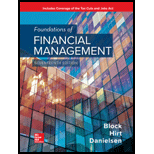
EBK FOUNDATIONS OF FINANCIAL MANAGEMENT
17th Edition
ISBN: 9781260464900
Author: BLOCK
Publisher: MCGRAW-HILL LEARNING SOLN.(CC)
expand_more
expand_more
format_list_bulleted
Question
Chapter 1, Problem 12DQ
Summary Introduction
To explain: The difference between the secondary and primary markets.
Introduction:
Types of markets:
Markets can be divided into various segments depending on the nature of their operations, such as domestic and international, corporate and government, secondary and primary markets, or capital and
Expert Solution & Answer
Want to see the full answer?
Check out a sample textbook solution
Students have asked these similar questions
QUESTION 1
Examine the information provided below and answer the following question.
(10 MARKS)
The hockey stick model of start-up financing, illustrated by the diagram below, has received a lot of attention in the
entrepreneurial finance literature (Cumming & Johan, 2013; Kaplan & Strömberg, 2014; Gompers & Lerner, 2020). The model
is often used to describe the typical funding and growth trajectory of many startups. The model emphasizes three main
stages, each of which reflects a different phase of growth, risk, and funding expectations.
Entrepreneur, 3 F's
Debt(banks & microfinance)
Research Business angels/Angel Venture funds/Venture capitalists
Merger, Acquisition
Grants
investors
PO
Public market
Growth (revenue)
Break even
point
Pide
1st round
Expansion
2nd round
3rd round
Research
commercial idea
Pre-seed
Initial concept
Seed
Early
Expansion
Financial stage
Late
IPO
Inception and
prototype
Figure 1. The hockey stick model of start-up financing (Lasrado & Lugmayr, 2013)
REQUIRED:…
critically discuss the hockey stick model of a start-up financing. In your response, explain the model and discibe its three main stages, highlighting the key characteristics of each stage in terms of growth, risk, and funding expectations.
Solve this problem please .
Chapter 1 Solutions
EBK FOUNDATIONS OF FINANCIAL MANAGEMENT
Knowledge Booster
Similar questions
- Take value of 1.01^-36=0.699 . step by steparrow_forwardsolve this question.Pat and Chris have identical interest-bearing bank accounts that pay them $15 interest per year. Pat leaves the $15 in the account each year, while Chris takes the $15 home to a jar and never spends any of it. After five years, who has more money?arrow_forwardWhat is corporate finance? explain all thingsarrow_forward
arrow_back_ios
SEE MORE QUESTIONS
arrow_forward_ios
Recommended textbooks for you
 Intermediate Financial Management (MindTap Course...FinanceISBN:9781337395083Author:Eugene F. Brigham, Phillip R. DavesPublisher:Cengage Learning
Intermediate Financial Management (MindTap Course...FinanceISBN:9781337395083Author:Eugene F. Brigham, Phillip R. DavesPublisher:Cengage Learning EBK CONTEMPORARY FINANCIAL MANAGEMENTFinanceISBN:9781337514835Author:MOYERPublisher:CENGAGE LEARNING - CONSIGNMENT
EBK CONTEMPORARY FINANCIAL MANAGEMENTFinanceISBN:9781337514835Author:MOYERPublisher:CENGAGE LEARNING - CONSIGNMENT

Intermediate Financial Management (MindTap Course...
Finance
ISBN:9781337395083
Author:Eugene F. Brigham, Phillip R. Daves
Publisher:Cengage Learning


EBK CONTEMPORARY FINANCIAL MANAGEMENT
Finance
ISBN:9781337514835
Author:MOYER
Publisher:CENGAGE LEARNING - CONSIGNMENT